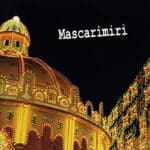A sensational and pure project is the Mascarimirì one (the Salento’s musicians); they carry and, in the meanwhile, hand on theirs fathers culture in the new musical journey in which they are creators of a new sound, though this sound is based on the search for the Salentinian musical tradition. From the old generations to the new ones, the Salento musicians give us, with a sonorous key, a Festa which is showed at dawn of each day, from January to December, in every place of Salento, from Ostuni to S.M. di Leuca, with blank shots, bells peal and musical roundabout.
Thanks to the FESTA we can dedicate to prayer, as to social events and to art.
The FESTA is still the same, to pay honour to a Patron Saint or to the Virgin, under various titles.
So it is an ancient FESTA, however it’s always new and beautiful. The first origin of this authentic people expression can be found in the upper middle age, under the Bisanzio empire, when timid and single processions about greek-bisantinian rite occurred in front of the rocky churchs, which were, and still are, frescoed by Saint Basilio’s or S. Calogeri’s monks. Under the two Sicilias reigns, the Borbons worked out that first essence, modifying its structure and giving it as a royalty to exploited and oppressed people, who, over the centuries, has properly rearranged it until it took the form we assist today in all the street of South Italy, expecially Salento.
An historic document of the second mid XVIII century talks about a noblewoman, a South Salento prince’s mother, who wanted the FESTA in honour to Immacolata at her’s own expense. This FESTA was celebrated into the main place, and it was formed of an octave, the sermon and the Saint Procession. Then there were drums, trumpets, men (“masculi”) shots and the church was decorated with a damask decoration.
The document doesn’t quote illuminations: in that age illuminations didn’t exist, and only after a period they would appear.
Mascarimirì, with their concept of “trad-innovation”, give an hope, putting the absent plug over the fashinating future of the traditional music and canto, which realized Salento as an international very interesting isle. They represent a phenomenon, which is not finished or settled down, because the whole cultural heritage of this isle is still an evolutioning turmoil which is keeping up with man; it’s impossible to stop it.
Even if the FESTA was short in its first age, today it is an explosion of unique settings, always in motion, which create faith, commercial and artistic wonderful events, everywhere in Salento.
In this place, every Saint has his history formed of miracles and legends which characterized the places where they are Patron Saints. Among the places of faith we can especially remember Scorrano (Saint Domenica), Torre Paduli (S. Rocco), Montesano Salentino (S. Donato), Copertino (S. Giuseppe), Oria (SS. Cosma e Damiano), Ostini/Lecce (S. Oronzo), Taranto (S. Cataldo), Brindisi (SS. Teodoro, Lorenzo and Leucio) , Galatina (SS. Pietro and Paolo), Cutrofiano (S.Antonio), Leuca (S. Maria).
Salento people pay the FESTA and, in special cases, as a historic date on calendar, the local institutions contributed.
A committee of Patronal FESTA, which changes every year, presents the FESTA and, as I said, develops great events such as: territory and tradition investigations, art exhibitions, concerts, fireworks and illuminations competitions. The FESTA helps people to socialize with other people cultures. It has been said a lot about the transient pomp of the FESTA in Salento. I belief that the same FESTA is born from a common way of faith, in which people have leant their comfortable identity, creting an authentic tradition.
Maybe this tradition has been revised in the centuries and it is reproduced today, but without cancelling the mark (which is still live and goes on). Even if the FESTA is made into the pomp, it mad richness and new activities. For example the famous band concerts, as “Città di Lecce”, “Città di Squinzano”, “Città di Carovigno”, “Città di Casarano”, which are always busy to play in the south italy squares, taking also place to meeting and international festivals. The same to the winning illumination and firework society, the seats of which are in Scorrano, Alessano, S. Donaci, Galatina and Parabita. The most important streets and squares in the world, such as those in New York, Vancouver, Tokyo, Roma, Parigi, Barcellona, Madrid, ask of these societies.
The Salentinian tradition is able to break every delay, crossing unimaginable places and border, giving to people their own hearth, their own love.
Mascarimirì, whose name in the Rom Salentinian language means “my virgin” have a long experience in twin projects. Since their foundation they have provoked experiences of similar cultures to their way of being musicians, based on the search for their own’s origins and their own’s daily creativity.
So an ancient sound and an ancient canto, but still new and beautiful.
Agostino Casciaro (trad. Giusy Colì)




